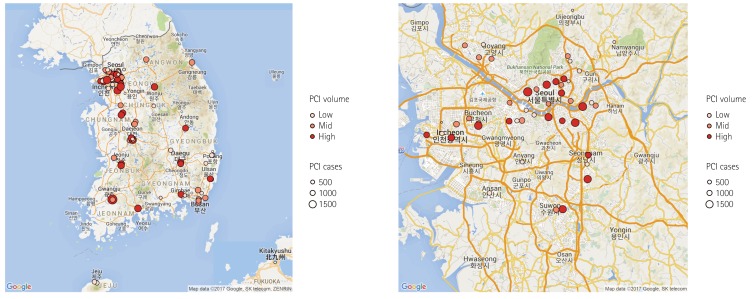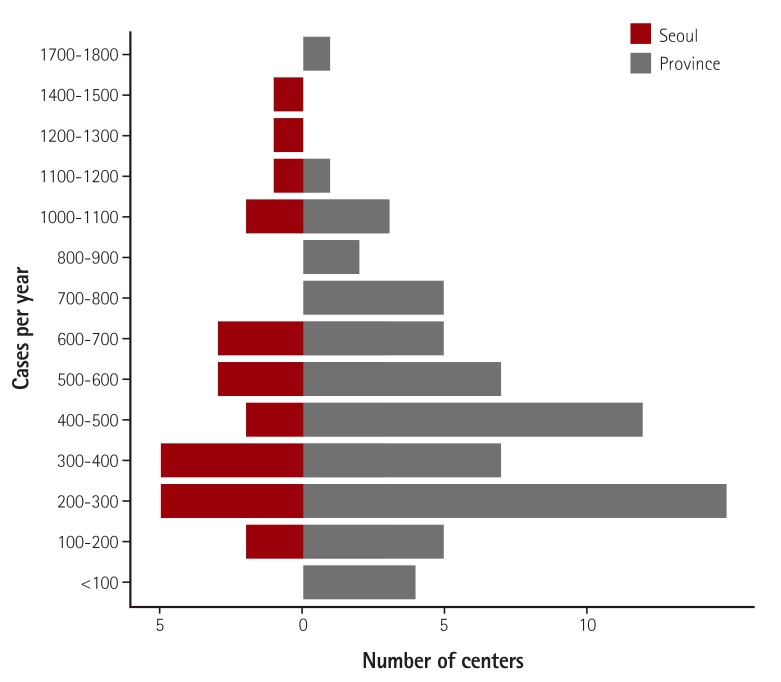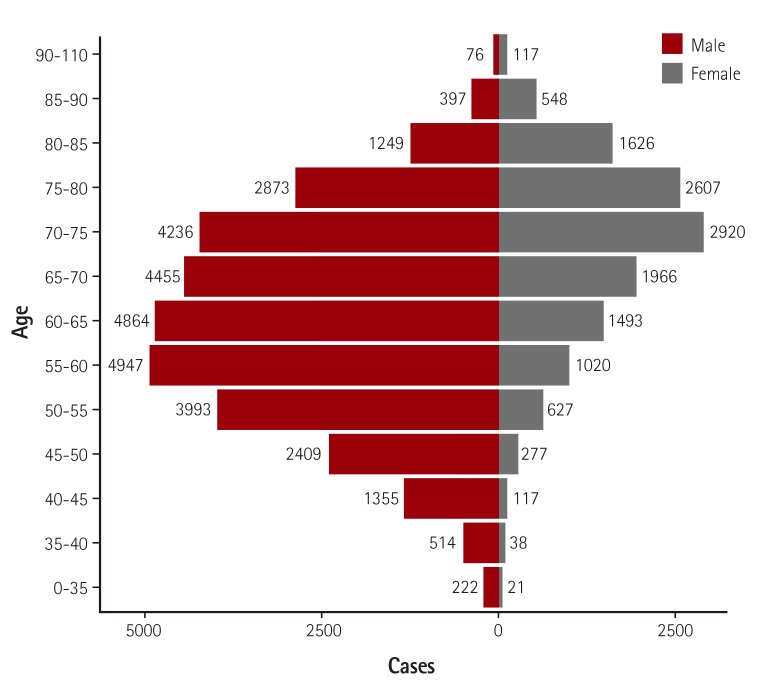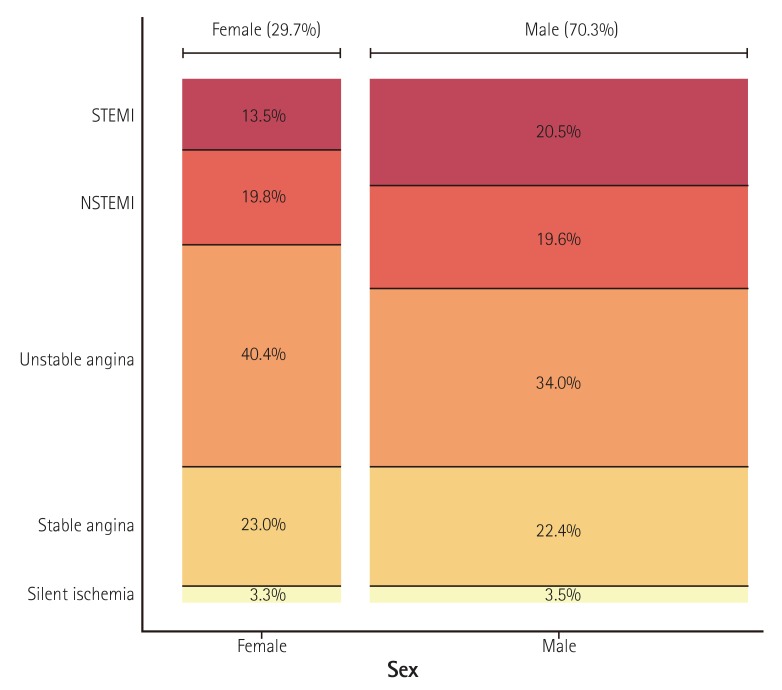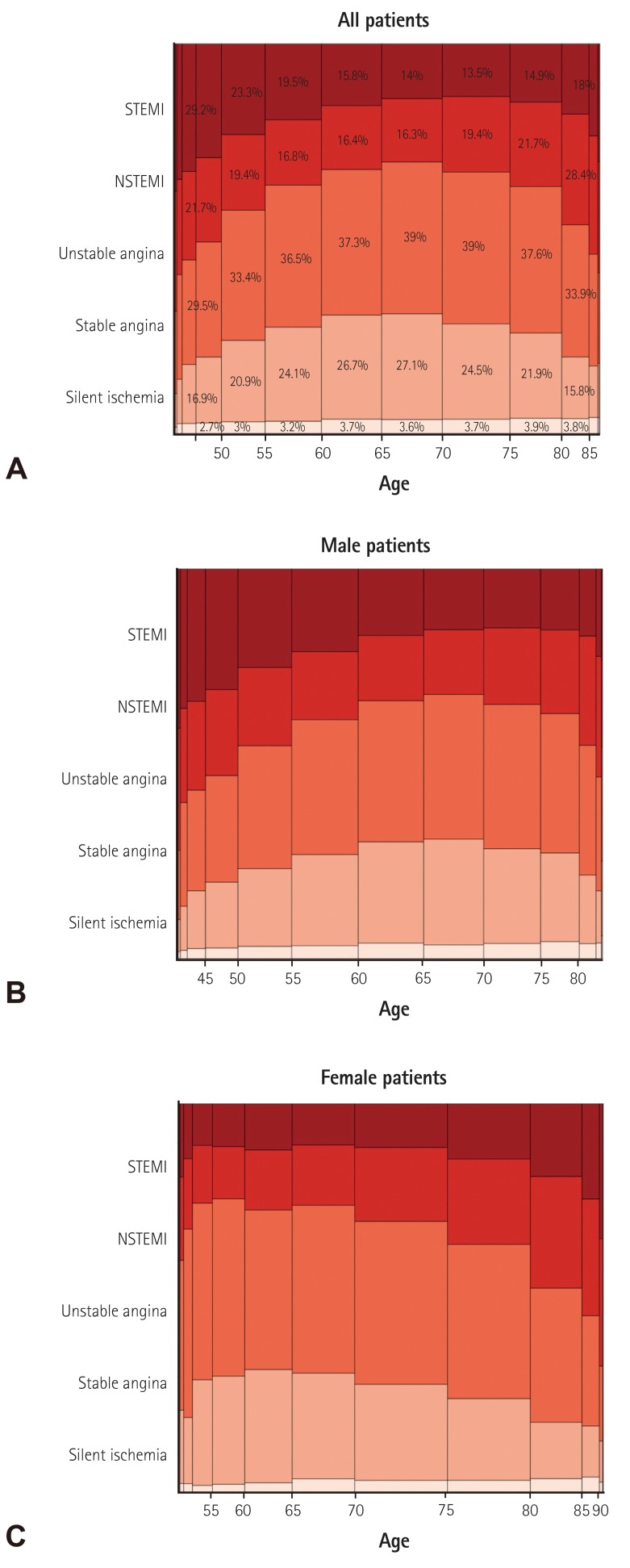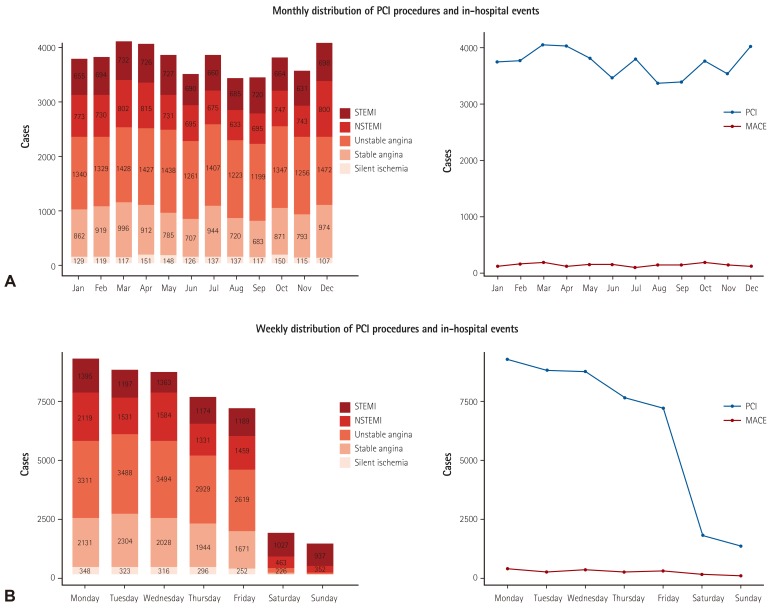The Current Status of Percutaneous Coronary Intervention in Korea: Based on Year 2014 Cohort of Korean Percutaneous Coronary Intervention (K-PCI) Registry
- Affiliations
-
- 1Division of Cardiology, Busan Paik Hospital, University of Inje College of Medicine, Busan, Korea.
- 2Department of Internal Medicine, Kangdong Sacred Heart Hospital, Hallym University Medical Center, Seoul, Korea.
- 3Division of Cardiology, St. Vincent's Hospital, The Catholic University of Korea, Suwon, Korea.
- 4Division of Cardiology, National Health Insurance Service Ilsan Hospital, Goyang, Korea.
- 5Division of Cardiology, Severance Cardiovascular Hospital, Yonsei University College of Medicine, Seoul, Korea.
- 6Division of Cardiology, Asan Medical Center, University of Ulsan College of Medicine, Seoul, Korea.
- 7Department of Internal Medicine, Seoul National University Hospital, Seoul, Korea. hyosoo@snu.ac.kr
- 8Division of Cardiology, Heart Center of Chonnam National University Hospital, Gwangju, Korea.
- 9Department of Internal Medicine, Chungbuk National University College of Medicine, Cheongju, Korea.
- 10Division of Cardiology, Keimyung University Dongsan Medical Center, Daegu, Korea.
- 11Division of Cardiology, Sanggye-Paik Hospital, University of Inje College of Medicine, Seoul, Korea.
- 12Heart Vascular and Stroke Institute, Samsung Medical Center, Sungkyunkwan University School of Medicine, Seoul, Korea.
- KMID: 2385387
- DOI: http://doi.org/10.4070/kcj.2017.0071
Abstract
- BACKGROUND AND OBJECTIVES
Although several multicenter registries have evaluated percutaneous coronary intervention (PCI) procedures in Korea, those databases have been limited by non-standardized data collection and lack of uniform reporting methods. We aimed to collect and report data from a standardized database to analyze PCI procedures throughout the country.
MATERIALS AND METHODS
Both clinical and procedural data, as well as clinical outcomes data during hospital stay, were collected based on case report forms that used a standard set of 54 data elements. This report is based on 2014 Korean PCI registry cohort data.
RESULTS
A total of 92 hospitals offered data on 44967 PCI procedures. The median age was 66.0 interquartile range 57.0-74.0 years, and 70.3% were men. Thirty-eight percent of patients presented with acute myocardial infarction and one-third of all PCI procedures were performed in an urgent or emergency setting. Non-invasive stress tests were performed in 13.9% of cases, while coronary computed tomography angiography was used in 13.7% of cases prior to PCI. Radial artery access was used in 56.1% of all PCI procedures. Devices that used PCI included drug-eluting stent, plain old balloon angioplasty, drug-eluting balloon, and bare-metal stent (around 91%, 19%, 6%, and 1% of all procedures, respectively). The incidences of in-hospital death, non-fatal myocardial infarction, and stroke were 2.3%, 1.6%, and 0.2%, respectively.
CONCLUSION
These data may provide an overview of the current PCI practices and in-hospital outcomes in Korea and could be used as a foundation for developing treatment guidelines and nationwide clinical research.
MeSH Terms
Figure
Cited by 6 articles
-
Impact of Hospital Volume of Percutaneous Coronary Intervention (PCI) on In-Hospital Outcomes in Patients with Acute Myocardial Infarction: Based on the 2014 Cohort of the Korean Percutaneous Coronary Intervention (K-PCI) Registry
Byong-Kyu Kim, Deuk-Young Nah, Kang Un Choi, Jun-Ho Bae, Moo-Yong Rhee, Jae-Sik Jang, Keon-Woong Moon, Jun-Hee Lee, Hee-Yeol Kim, Seung-Ho Kang, Woo hyuk Song, Seung Uk Lee, Byung-Ju Shim, Hangjae Chung, Min Su Hyon
Korean Circ J. 2020;50(11):1026-1036. doi: 10.4070/kcj.2020.0172.Ischemia-based Coronary Revascularization: Beyond Anatomy and Fractional Flow Reserve
Hong-Seok Lim, Kyoung-Woo Seo, Myeong-Ho Yoon, Hyoung-Mo Yang, Seung-Jea Tahk
Korean Circ J. 2018;48(1):16-23. doi: 10.4070/kcj.2017.0177.Dose Coronary Angiography Suffice for Assessment of Intermediate Coronary Stenosis?
Sung Gyun Ahn, Sang Jun Lee
Korean Circ J. 2019;49(11):1033-1034. doi: 10.4070/kcj.2019.0227.The Current Status of Intervention for Intermediate Coronary Stenosis in the Korean Percutaneous Coronary Intervention (K-PCI) Registry
Jin-Ho Kim, Woonggil Choi, Ki-Chang Kim, Chang-Wook Nam, Bum-Kee Hong, June-Hong Kim, Doo Soo Jeon, Jang-Whan Bae, Sang-Hyun Kim, Keon-Woong Moon, Byung-Ryul Cho, Doo Il Kim, Jae-Sik Jang
Korean Circ J. 2019;49(11):1022-1032. doi: 10.4070/kcj.2019.0074.Descriptive Study on the Korean Status of Percutaneous Coronary Intervention Using National Health Insurance Service-National Sample Cohort (NHIS-NSC) Database: Focused on Temporal Trend
Jidong Sung, Kyung Pyo Hong
Korean Circ J. 2019;49(12):1155-1163. doi: 10.4070/kcj.2019.0080.Effect of Operator Volume on In-Hospital Outcomes Following Primary Percutaneous Coronary Intervention for ST-Elevation Myocardial Infarction: Based on the 2014 Cohort of Korean Percutaneous Coronary Intervention (K-PCI) Registry
Jung-Hee Lee, Sang-Yong Eom, Ung Kim, Chan-Hee Lee, Jang-Won Son, Dong Woon Jeon, Jang-Ho Bae, Seok Kyu Oh, Kwang Soo Cha, Yongsung Suh, Young Youp Koh, Tae-Hyun Yang, Dae keun Shim, Jang-Whan Bae, Jong-Seon Park
Korean Circ J. 2020;50(2):133-144. doi: 10.4070/kcj.2019.0206.
Reference
-
1. Grech ED. ABC of interventional cardiology: percutaneous coronary intervention. I: history and development. BMJ. 2003; 326:1080–1082. PMID: 12750213.2. Amsterdam EA, Wenger NK, Brindis RG, et al. 2014 AHA/ACC guideline for the management of patients with non-ST-elevation acute coronary syndromes: executive summary: a report of the American College of Cardiology/American Heart Association Task Force on Practice Guidelines. Circulation. 2014; 130:2354–2394. PMID: 25249586.3. Authors/Task Force members. Windecker S, Kolh P, et al. 2014 ESC/EACTS Guidelines on myocardial revascularization: the task force on myocardial revascularization of the European Society of Cardiology (ESC) and the European Association for Cardio-Thoracic Surgery (EACTS). Developed with the special contribution of the European Association of Percutaneous Cardiovascular Interventions (EAPCI). Eur Heart J. 2014; 35:2541–2619. PMID: 25173339.4. Levine GN, Bates ER, Blankenship JC, et al. 2011 ACCF/AHA/SCAI guideline for percutaneous coronary intervention: a report of the American College of Cardiology Foundation/American Heart Association Task Force on practice guidelines and the Society for Cardiovascular Angiography and Interventions. Circulation. 2011; 124:e574–e651. PMID: 22064601.5. O'Gara P, Kushner F, Ascheim D, et al. 2013 ACCF/AHA guideline for the management of ST-elevation myocardial infarction: a report of the American College of Cardiology Foundation/American Heart Association Task Force on practice guidelines. J Am Coll Cardiol. 2013; 61:e78–e140. PMID: 23256914.6. Bashore TM, Balter S, Barac A, et al. 2012 American College of Cardiology Foundation/Society for Cardiovascular Angiography and Interventions expert consensus document on cardiac catheterization laboratory standards update: A report of the American College of Cardiology Foundation Task Force on Expert Consensus documents developed in collaboration with the Society of Thoracic Surgeons and Society for Vascular Medicine. J Am Coll Cardiol. 2012; 59:2221–2305. PMID: 22575325.7. Krumholz HM, Anderson JL, Bachelder BL, et al. ACC/AHA 2008 performance measures for adults with ST-elevation and non-ST-elevation myocardial infarction: a report of the American College of Cardiology/American Heart Association Task Force on Performance Measures (Writing Committee to develop performance measures for ST-elevation and non-ST-elevation myocardial infarction): developed in collaboration with the American Academy of Family Physicians and the American College of Emergency Physicians: endorsed by the American Association of Cardiovascular and Pulmonary Rehabilitation, Society for Cardiovascular Angiography and Interventions, and Society of Hospital Medicine. Circulation. 2008; 118:2596–2648. PMID: 19001027.8. Nallamothu BK, Tommaso CL, Anderson HV, et al. ACC/AHA/SCAI/AMA-convened PCPI/NCQA 2013 performance measures for adults undergoing percutaneous coronary intervention: a report of the American college of cardiology/American heart association task force on performance measures, the society for cardiovascular angiography and interventions, the American medical association-convened physician consortium for performance improvement, and the national committee for quality assurance. Circulation. 2014; 129:926–949. PMID: 24357402.9. Sim DS, Jeong MH, Kang JC. Current management of acute myocardial infarction: experience from the Korea acute myocardial infarction registry. J Cardiol. 2010; 56:1–7. PMID: 20554156.10. Hahn JY, Chun WJ, Kim JH, et al. Predictors and outcomes of side branch occlusion after main vessel stenting in coronary bifurcation lesions: results from the COBIS II Registry (COronary BIfurcation Stenting). J Am Coll Cardiol. 2013; 62:1654–1659. PMID: 23954335.11. Lee PH, Lee SW, Park HS, et al. Successful recanalization of native coronary chronic total occlusion is not associated with improved long-term survival. JACC Cardiovasc Interv. 2016; 9:530–538. PMID: 26947387.12. Lee SH, Jeong MH, Han KR, et al. comparison of transradial and transfemoral approaches for percutaneous coronary intervention in patients with acute coronary syndrome and anemia. Am J Cardiol. 2016; 117:1582–1587. PMID: 27018932.13. Kim KH, Kim CH, Jeong MH, et al. Differential benefit of statin in secondary prevention of acute myocardial infarction according to the level of triglyceride and high density lipoprotein cholesterol. Korean Circ J. 2016; 46:324–334. PMID: 27275169.14. Dehmer GJ, Weaver D, Roe MT, et al. A contemporary view of diagnostic cardiac catheterization and percutaneous coronary intervention in the United States: a report from the CathPCI registry of the national cardiovascular data registry, 2010 through June 2011. J Am Coll Cardiol. 2012; 60:2017–2031. PMID: 23083784.15. Anderson HV, Shaw RE, Brindis RG, et al. A contemporary overview of percutaneous coronary interventions. The American College of Cardiology-National Cardiovascular Data Registry (ACC-NCDR). J Am Coll Cardiol. 2002; 39:1096–1103. PMID: 11923031.16. Banning AP, Baumbach A, Blackman D, et al. Percutaneous coronary intervention in the UK: recommendations for good practice 2015. Heart. 2015; 10(Suppl 3):1–13.17. Garcia del Blanco B, Hernandez Hernandez F, Rumoroso Cuevas JR, Trillo Nouche R. Spanish cardiac catheterization and coronary intervention registry. 23rd official report of the Spanish Society of Cardiology Working Group on Cardiac Catheterization and Interventional Cardiology (1990-2013). Rev Esp Cardiol (Engl Ed). 2014; 67:1013–1023. PMID: 25455754.18. Harnek J, Nilsson J, Friberg O, et al. The 2011 outcome from the Swedish Health Care Registry on Heart Disease (SWEDEHEART). Scand Cardiovasc J. 2013; 47(Suppl 62):1–10. PMID: 23941732.19. Jernberg T, Attebring MF, Hambraeus K, et al. The Swedish web-system for enhancement and development of evidence-based care in heart disease evaluated according to recommended therapies (SWEDEHEART). Heart. 2010; 96:1617–1621. PMID: 20801780.20. Zeymer U, Zahn R, Hochadel M, et al. Incications and complications of invasive diagnostic procedures and percutaneous coronary interventions in the year 2003. Results of the quality control registry of the Arbeitsgemeinschaft Leitende Kardiologische Krankenhausarzte (ALKK). Z Kardiol. 2005; 94:392–398. PMID: 15940439.21. Bangalore S, Gupta N, Guo Y, Feit F. Trend in the use of drug eluting stents in the United States: insight from over 8.1 million coronary interventions. Int J Cardiol. 2014; 175:108–119. PMID: 24852837.22. Kalesan B, Pilgrim T, Heinimann K, et al. Comparison of drug-eluting stents with bare metal stents in patients with ST-segment elevation myocardial infarction. Eur Heart J. 2012; 33:977–987. PMID: 22362513.23. Dattilo PB, Prasad A, Honeycutt E, Wang TY, Messenger JC. Contemporary patterns of fractional flow reserve and intravascular ultrasound use among patients undergoing percutaneous coronary intervention in the United States: insights from the National Cardiovascular Data Registry. J Am Coll Cardiol. 2012; 60:2337–2339. PMID: 23194945.24. Pothineni NV, Shah NS, Rochlani Y, et al. U.S. Trends in Inpatient Utilization of Fractional Flow Reserve and Percutaneous Coronary Intervention. J Am Coll Cardiol. 2016; 67:732–733. PMID: 26868697.25. Peterson ED, Dai D, DeLong ER, et al. Contemporary mortality risk prediction for percutaneous coronary intervention: results from 588,398 procedures in the National Cardiovascular Data Registry. J Am Coll Cardiol. 2010; 55:1923–1932. PMID: 20430263.26. Yan BP, Clark DJ, Buxton B, et al. Clinical characteristics and early mortality of patients undergoing coronary artery bypass grafting compared to percutaneous coronary intervention: insights from the Australasian Society of Cardiac and Thoracic Surgeons (ASCTS) and the Melbourne Interventional Group (MIG) Registries. Heart Lung Circ. 2009; 18:184–190. PMID: 19268632.27. Committee for the Korean Guidelines for the Management of Dyslipidemia. 2015 Korean guidelines for the management of dyslipidemia: executive summary (English translation). Korean Circ J. 2016; 46:275–306. PMID: 27275165.28. De Bruyne B, Pijls NH, Kalesan B, et al. Fractional flow reserve-guided PCI versus medical therapy in stable coronary disease. N Engl J Med. 2012; 367:991–1001. PMID: 22924638.29. Jang JS, Song YJ, Kang W, et al. Intravascular ultrasound-guided implantation of drug-eluting stents to improve outcome: a meta-analysis. JACC Cardiovasc Interv. 2014; 7:233–243. PMID: 24529934.30. Hong SJ, Kim BK, Shin DH, et al. Effect of intravascular ultrasound-guided vs angiography-guided everolimus-eluting stent implantation: the ivus-xpl randomized clinical trial. JAMA. 2015; 314:2155–2163. PMID: 26556051.
- Full Text Links
- Actions
-
Cited
- CITED
-
- Close
- Share
- Similar articles
-
- Current Status of Coronary Intervention in Patients with ST-Segment Elevation Myocardial Infarction and Multivessel Coronary Artery Disease
- Unprotected Left Main Percutaneous Coronary Intervention in a 108-Year-Old Patient
- The Second Report from K-PCI Registry: a Step toward Continuous Systemic Monitoring of Korean Percutaneous Coronary Intervention Practice
- Terrible Stent Thrombosis Induced by a Treadmill Test Performed Three Days after Percutaneous Coronary Intervention
- A Case of a Successful Percutaneous Coronary Intervention Using Percusurge(r) System in a Massive Intracoronary Thrombi Patient

